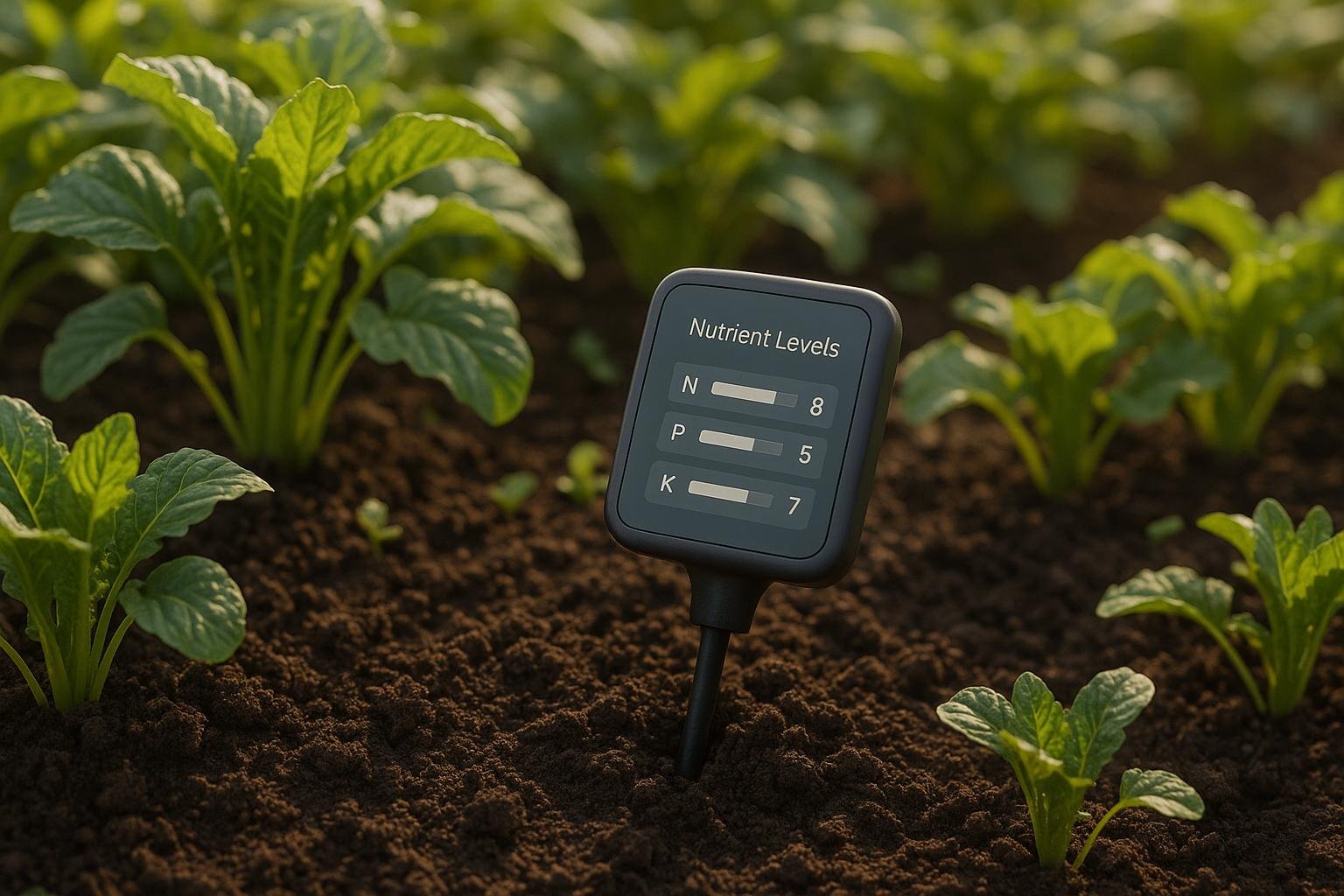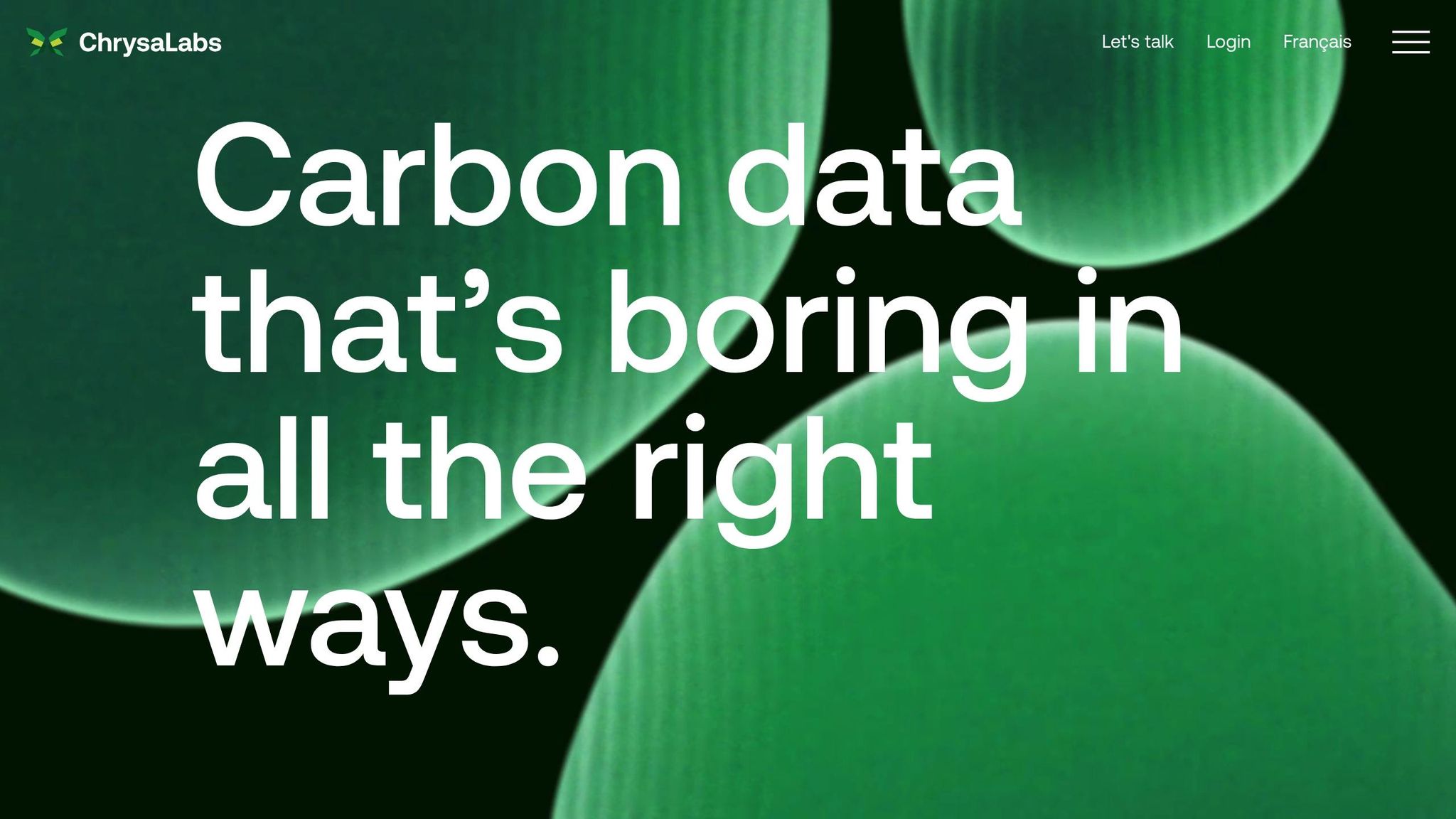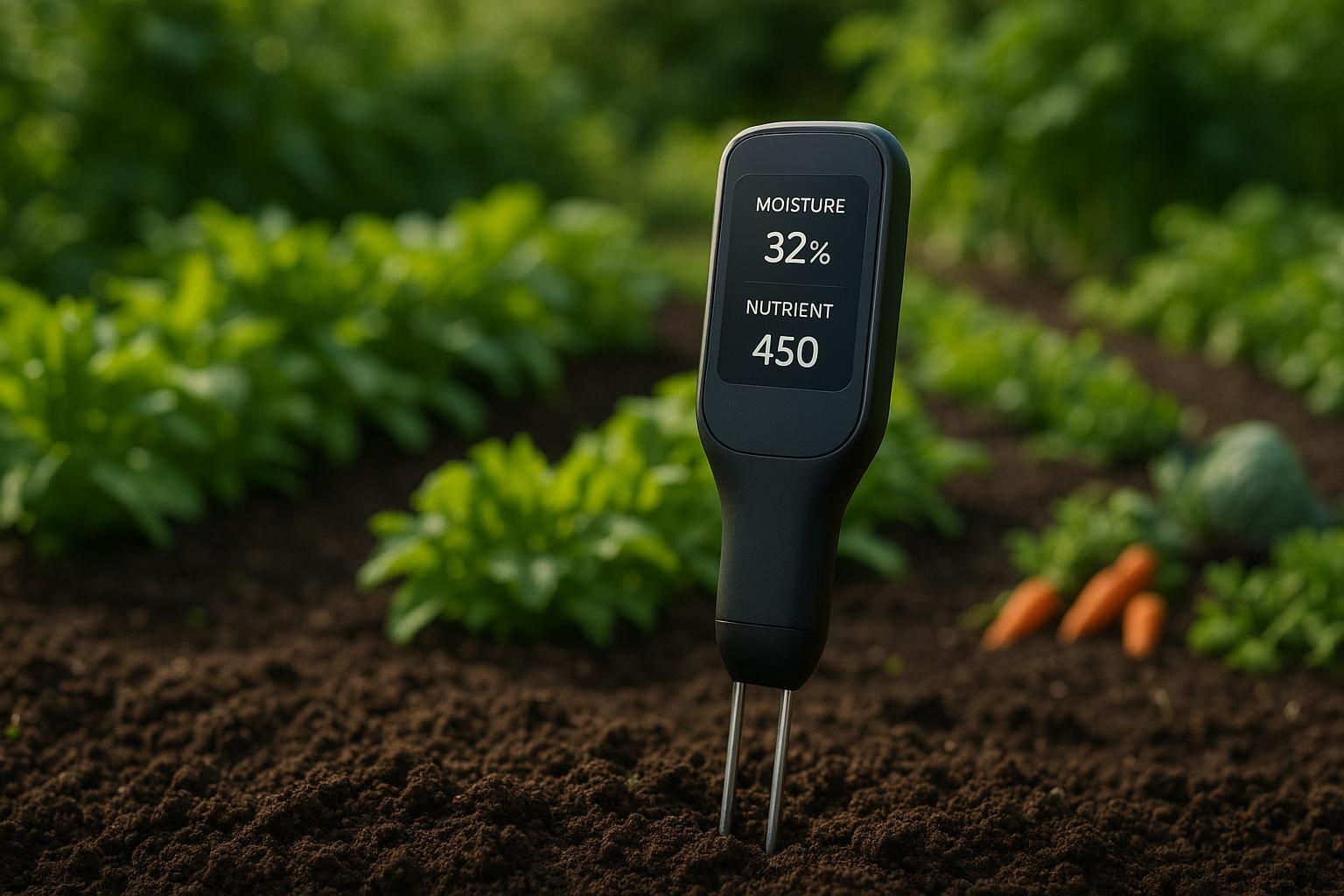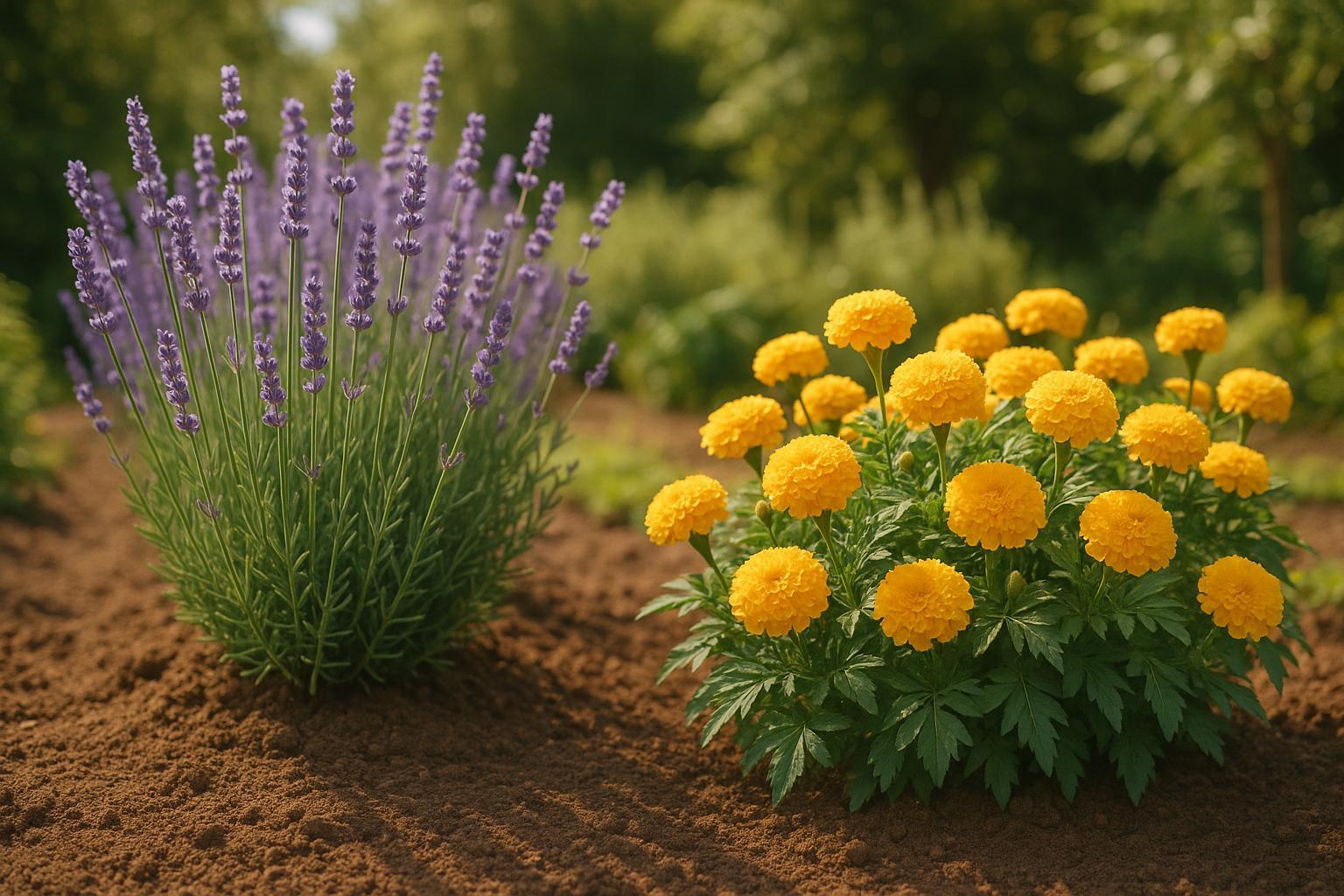Real-Time Nutrient Monitoring: Benefits for Gardeners

Real-time nutrient monitoring is changing how gardeners care for plants. Instead of guessing or waiting for visible problems, this technology uses sensors and data to provide instant insights into soil health. Here's why it matters:
- Early Problem Detection: Spot nutrient imbalances before they harm plants.
- Better Decisions: Get actionable data on pH, moisture, and nutrient levels.
- Healthier Plants: Address issues quickly for stronger growth and higher yields.
- Cost Savings: Use resources like water and fertilizer more efficiently.
With tools like AIGardenPlanner, gardeners can also get tailored advice based on their soil and environment, making plant care simpler and more effective. This approach ensures plants thrive while saving time and money.
ChrysaLabs' Real Time Soil Measurement


Common Signs and Risks of Nutrient Deficiencies
Catching nutrient deficiencies early is crucial for maintaining healthy plants. Often, these deficiencies don't show obvious signs until the damage is already done. By the time visible symptoms appear, the health of your plants may already be at risk. Spotting these early warning signs can make all the difference in preventing long-term harm to your garden.
Visual Symptoms to Watch For
Plants often reveal nutrient deficiencies through specific visual cues, though these can sometimes resemble damage caused by pests or environmental stress. For instance:
- Nitrogen deficiency: Typically shows as yellowing leaves starting at the base, as nitrogen is redirected to support new growth.
- Phosphorus deficiency: Can lead to changes in leaf color and slower growth.
- Potassium deficiency: Often causes browning or "scorching" along the edges of leaves.
- Iron and magnesium deficiencies: Both can result in interveinal chlorosis (yellowing between veins), though the pattern of affected leaves can differ.
Recognizing these symptoms early allows for timely action, reducing the risk of further damage. Real-time monitoring can be especially helpful in identifying these subtle signs before they escalate into more serious problems.
Consequences of Late Detection
When nutrient deficiencies go unnoticed, the damage can quickly become severe. By the time symptoms are visible, the deficiency has often progressed to a point where it disrupts the plant's growth and development [1]. Advanced deficiencies can lead to stunted growth, crop failure during the seedling stage, and lower-quality produce. Worse yet, attempting to correct the issue too late can create other problems, like soil imbalances or wasted resources [2]. Over-fertilization, for example, may cause nutrient toxicity and harm soil fertility [2]. Early detection through real-time monitoring can help you avoid these complications and keep your plants thriving.
How Real-Time Nutrient Monitoring Works
Real-time nutrient monitoring takes the guesswork out of gardening by offering precise, data-driven insights. Using advanced sensors, machine learning, and user-friendly interfaces, it gives gardeners instant updates on soil health and nutrient levels. This tech-driven approach forms the backbone of the detailed processes described below.
The Technology Behind the Solution
Modern sensors do the heavy lifting by continuously measuring a range of factors like potassium, phosphorus, nitrogen, temperature, pH levels, moisture content, and electrical conductivity. These sensors are connected to microcontrollers that gather and relay the data in real time.
Once collected, the data is analyzed by machine learning models. Artificial neural networks, in particular, focus on key nutrients - nitrogen, phosphorus, and potassium - as well as pH levels, providing accurate predictions for crop needs [3]. The processed information is then displayed on mobile apps or web dashboards, transforming complex soil data into easy-to-understand visuals for gardeners.
Data Collection and Analysis
This uninterrupted stream of data not only offers immediate insights but also helps refine machine learning models over time, improving their accuracy [3].
Research shows these systems can predict soil conditions with over 80% accuracy. They’re even capable of identifying small changes, like a gradual drop in nitrogen levels or a slight pH shift, long before these issues visibly affect plants. These precise measurements allow the system to send timely alerts, ensuring gardeners can take action before problems escalate.
Actionable Alerts and Recommendations
The real power of nutrient monitoring lies in its ability to notify gardeners when action is needed. These systems issue alerts when specific thresholds are reached, enabling quick and informed decision-making [4].
Based on sensor readings, the system can suggest targeted solutions like re-fertilization, adjusting pH levels, scheduling watering, or even pinpointing the best planting times [4]. By providing tailored recommendations specific to the soil’s current condition, gardeners can avoid common pitfalls like under-fertilizing or over-fertilizing, ensuring healthier plants and better yields.
sbb-itb-4d6a8dd
🚀 Ready to Reinvent Your Garden?
Join thousands of homeowners who have transformed their gardens using our AI design tool. Upload one photo to explore endless possibilities.
Get your AI garden designs →Key Benefits of Real-Time Nutrient Monitoring
Real-time nutrient monitoring transforms gardening by providing actionable insights into critical factors like nutrient levels, pH, and moisture. This constant stream of data allows gardeners to take proactive measures, ensuring plants get the care they need when they need it.
Early Detection and Prevention
One of the standout advantages of real-time monitoring is its ability to identify nutrient issues before they spiral out of control. Traditional methods often depend on visible signs of stress, which usually show up only after significant damage has already been done. With real-time monitoring, nutrient stress can be identified within just three days of onset[5]. This early detection enables quick intervention, minimizing crop stress and reducing the risk of disease.
Smarter Resource Use and Cost Efficiency
By relying on real-time soil data instead of fixed schedules, these systems help gardeners apply fertilizers more efficiently. Monitoring soil moisture alongside nutrient levels prevents overwatering and ensures plants get exactly what they need. This precision not only conserves resources but also cuts down on unnecessary expenses.
Improved Plant Health and Higher Yields
When plants receive timely adjustments to their nutrient intake, they experience less stress and are less prone to disease. This leads to healthier plants and, ultimately, higher yields. Real-time data empowers gardeners to maintain optimal growing conditions, ensuring their crops thrive.
Using AI Tools for Personalized Garden Care
AI tools are taking garden management to the next level by building on real-time nutrient insights. These tools don't just monitor nutrients - they provide tailored care solutions that align with your gardening goals. One standout example is AIGardenPlanner, which uses real-time soil and environmental data to offer customized recommendations for plant care and selection.
Personalized Plant Recommendations
With AIGardenPlanner, you get plant suggestions that are fine-tuned to your garden's specific needs. The AI evaluates factors like your climate zone, soil type, and local weather patterns to recommend plants that will thrive in your environment [6][7]. This means you can confidently choose species that are naturally suited to your garden, making the planting process both efficient and rewarding.
Automated Growing Guides and Maintenance
The platform also provides dynamic growing guides that adapt to your garden's ever-changing conditions. These guides include real-time updates on watering schedules, sunlight requirements, soil preferences, and even seasonal maintenance tips [6][7]. It's like having a personal gardening assistant that keeps you informed and on track throughout the year.
Professional Tools for Homeowners and Landscapers
Whether you're a home gardener or a professional landscaper, AIGardenPlanner offers tools designed to make garden management easier. With features like commercial licensing and an easy-to-use interface, it supports advanced garden design and care. You can manage multiple gardens efficiently while making data-driven decisions to keep plants healthy and vibrant.
Conclusion: Changing Gardening with Real-Time Insights
Real-time nutrient monitoring is reshaping how gardeners care for their plants. Instead of waiting for problems to arise, gardeners can now pinpoint and resolve issues before they affect plant health. This shift from guesswork to data-driven decisions allows for immediate, practical actions that benefit both plants and the environment.
By understanding exactly what nutrients the soil needs and when, gardeners can avoid over-fertilizing - a practice that not only saves money but also protects plants and reduces waste. For gardeners across the United States, where climate conditions vary widely from one region to another, this precision is especially valuable.
AI-powered tools like AIGardenPlanner take this concept even further by merging real-time data with smart recommendations. Using factors like your location, climate, and soil composition, AIGardenPlanner generates tailored advice to help you achieve your gardening goals. With access to over 50 garden styles and adaptive growing guides, this platform makes it easier than ever to manage your garden like a pro, no matter your experience level.
This level of personalization elevates plant care for everyone, whether you're tending a small backyard plot or managing multiple properties as a landscaper. Real-time nutrient monitoring equips gardeners with the data they need to make smarter, more informed decisions, ensuring better outcomes for plants and gardeners alike.
FAQs
What are the advantages of real-time nutrient monitoring compared to traditional methods?
Real-time nutrient monitoring brings a host of benefits compared to older methods, primarily by delivering immediate and accurate insights into soil nutrient levels. With this information at their fingertips, gardeners can quickly address any deficiencies, promoting healthier plants and using resources more efficiently.
Although the upfront investment in sensors and related technology might seem steep, it pays off over time. By cutting down on fertilizer waste, conserving water, and reducing manual labor, this approach ultimately saves money. Plus, it's a smarter, more resource-conscious way to manage nutrients, making it an appealing option for gardeners looking to improve both their results and their environmental impact.
What technologies are used in real-time nutrient monitoring, and how do they ensure accurate results?
Real-time nutrient monitoring uses smart sensors - like pH, electrical conductivity (EC), and ion-specific sensors - to directly measure nutrient levels in soil or water. These sensors constantly gather data and transmit it to a control unit, often via IoT-enabled systems, for immediate analysis.
The control unit then processes this information and collaborates with actuators, such as dosing pumps, to automatically adjust nutrient delivery. This ensures plants get the right nutrients exactly when they need them, supporting healthy growth while minimizing waste. By combining these technologies, gardeners gain precise insights that make optimizing their gardens simpler and more efficient.
Can real-time nutrient monitoring work for indoor, outdoor, and urban gardens?
Real-time nutrient monitoring is versatile enough to work in all kinds of gardens - whether you're tending to indoor setups, outdoor plots, or urban green spaces. With tools like optical sensors, spectral analysis, and IoT-based systems, you can keep a close eye on plant health and nutrient levels with impressive accuracy.
For indoor or vertical gardens, sensors can handle nutrient adjustments automatically, ensuring plants get exactly what they need. In urban gardens, IoT networks offer real-time insights, helping gardeners manage resources with greater efficiency. These technologies make it easier to grow vibrant, healthy plants in any environment.
🎨 Visualize Your Dream Garden Today!
Transform any outdoor space into a professional landscape design in minutes. Just upload a photo, choose your style, and let our AI do the rest.
Start your garden transformation now →Related posts
Related Articles

Natural Stone Pavers: Benefits for Garden Paths
Explore the advantages of natural stone pavers for garden paths, including durability, style, and eco-friendliness.

Drought-Resistant Landscaping: A Complete Guide
Transform your garden into a stunning, drought-resistant landscape with smart design, plant choices, and efficient watering methods.

Top 7 Soil Sensors for Moisture and Nutrient Tracking
Explore the top soil sensors for monitoring moisture and nutrients, enhancing your gardening efficiency and plant health.

Ultimate Guide to Eco-Friendly Decking
Explore the benefits and options of eco-friendly decking materials that enhance your outdoor space while promoting sustainability.

How AI Matches Plants to Your Garden Style
AI tools revolutionize garden planning by providing personalized plant recommendations based on your garden style, climate, and preferences.

Best Plant Pairings with AI Suggestions
Explore how AI tools revolutionize gardening by providing personalized plant pairings based on climate, soil, and user preferences.